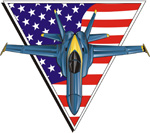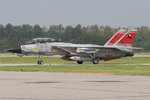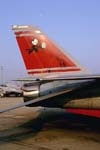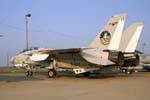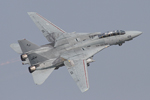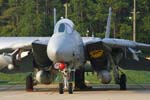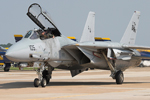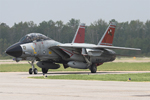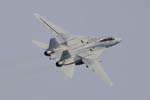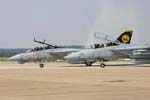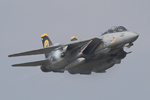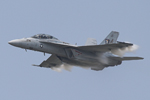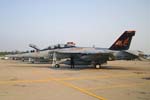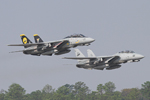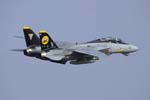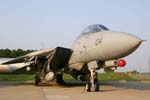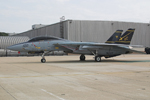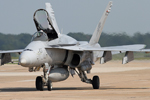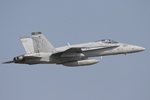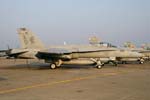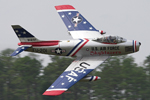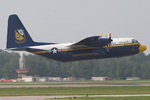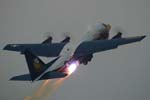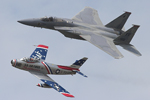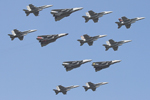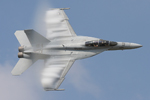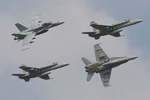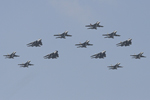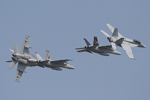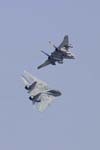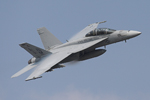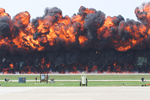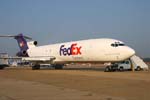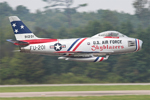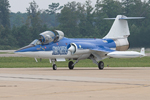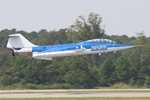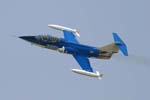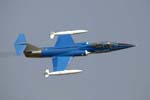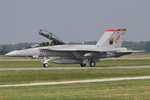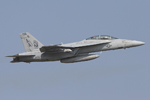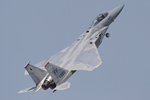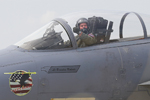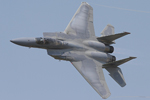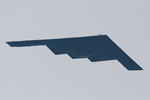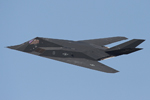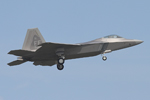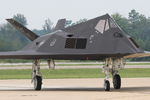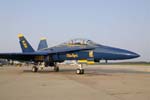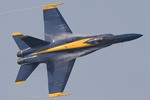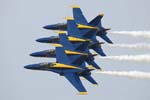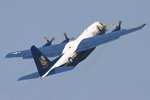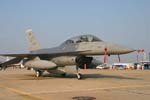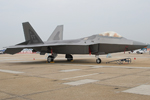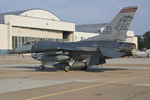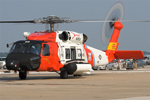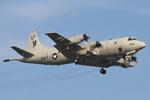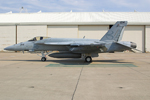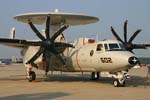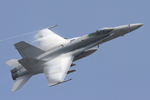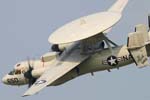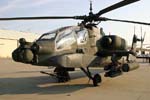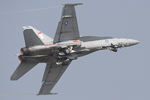After attending NAS Oceana Air Show in 2004 for the first time, and returning again in 2005 for the last solo tactical demonstration of the F-14 Tomcat, I just had to go back one last time in 2006. Just for the Tomcat. Sure I’d seen quite a bit of Tomcat action in the last two years, both at Oceana and aboard CVN-71 USS Theodore Roosevelt in the Persian Gulf, but when it was announced that the last active F-14 unit, Fighter Squadron Thirty One (VF-31) would be present at Oceana for the 2006 Air Show, I had to have one last look at this Grumman Cat, and witness her go out in style! |
|
|
The F-14 first flew on December 21, 1970 and was introduced into service with the US Navy in September 1974. Tomcats have been witness to many conflicts to date including the evacuation of Vietnam, Libya, Grenada, Lebanon, and the Persian Gulf Wars. The Tomcat was intended as an un-compromised air superiority fighter and interceptor, tasked with defending carrier battle groups against Soviet aircraft armed with cruise missiles. The F-14 was designed with some air-to-ground capability, but this was not explored until late in its career. During the last cruise with the aircraft carrier USS Theodore Roosevelt, Fighter Squadron Thirty One (VF-31) and Fighter Squadron Two One Three (VF-213) Tomcats were equipped to carry the LANTIRN targeting system for the use of laser-guided bombs and other precision-guided weapons. The F-14 was also equipped to carry the Tactical Air Reconnaissance Pod System, giving the Navy what was then its only manned tactical reconnaissance platform. As a strike fighter, the Tomcat was capable of deploying an assortment of air-to-ground ordnance, in various configurations, while simultaneously carrying air-to-air missiles. |
Sadly, a combination of man hours and funds has created an end of an era for the Tomcat that was made famous by the Hollywood movie ‘Top Gun’. During the last few years of its Navy career, up to 40 man hours of maintenance were required for just one hour's flying time. That’s far too expensive, so in November 1999, a new aircraft entered service with the US Navy, as a replacement for the Tomcat; the Boeing F/A-18E/F Super Hornet. The Super Hornet is a now combat-proven, fifth generation strike fighter with built-in versatility. The Super Hornet's suite of integrated and networked systems provides enhanced interoperability, total force support for the combatant commander and for the troops on the ground. It has the capability, flexibility and performance necessary to modernize any air or naval aviation force of any country. The F/A-18E/F Super Hornet is truly a multi-role aircraft able to perform virtually every mission in the tactical spectrum including air superiority, day/night strike with precision-guided weapons, fighter escort, close air support, suppression of enemy air defence, maritime strike, reconnaissance, forward air control and tanker. The Super Hornet is capable of converting from one mission to another as simply as just flipping a switch. |
|
|
For the men and women that have had the honour of strapping into the F-14, it will always be remembered as the most perfect synergy of science, engineering and inspiration that man has ever produced. As it soared above the ocean, nearing a speed of Mach 2, the F-14 Tomcat approached its retirement from active duty with style, grace and ferocity. |
Naval Air Station Oceana lies 16 miles East of the City of Norfolk but within the city limits of Virginia Beach, Virginia. The Air Station is tucked away among the tall trees, swamps and farmland just west of the waterfront. It really is the East Coast 'Master Jet Base', home to eight F/A-18C units, seven F/A-18E/F units, one Fleet Replacement Squadron with F/A-18Cs, Ds, Es and Fs, one F/A-18A/B adversary unit and the last remaining Tomcat unit, VF-31 'Tomcatters', which are due to begin transition to VFA-22s F/A-18Es in late September 2006. In total over 200 aircraft are assigned to the base. Each year the base hosts its annual Air Show, towards the middle or end of September. The event is one of the best Air Shows on the East Coast and is well known for its flying demonstrations of Navy and Air Force hardware. |
|
|
The action all began on the Friday evening. After a full rehearsal for the media and invited guests during the daytime, NAS Oceana opened its gates to the public at 1700hrs for the Twilight Evening show to begin. Along with several civilian acts, taking part in spectacular displays that evening was the United States Air Force F-15 East Coast Solo demonstration together with Dale Snodgrass in his F-86 Sabre for the heritage flight flypast. There was also a solo demonstration by the US Navy’s F/A-18C aircraft and some high speed passes at night by an F/A-18F Super Hornet which lit up the sky with its afterburner. Fat Albert, the Blue Angels KC-130T support aircraft, provided a night time Jet Assisted Take Off (JATO) and closing the show on Friday evening was a spectacular fireworks display. |
Saturday and Sunday saw the main public days of the weekend, with gates opening at 0800, and the flying display beginning at 1000. The first major military item opening the show was a US Navy E-2C Hawkeye operated by Carrier Airborne Early Warning Squadron 'One Two Zero' (VAW-120) from nearby NS Norfolk. Following this, launching just after 1000 was one of the main highlights of the event, known as the ‘Fleet Aircraft Launch’. Thirteen jets, which included a solo F/A-18F Super Hornet operated by Strike Fighter Squadron 'One Zero Six' (VFA-106), four F-14D Tomcats operated by Fighter Squadron 'Thirty One' (VF-31), four F/A-18C Hornets operated by Strike Fighter Squadrons 'Eighty Seven' (VFA-87) and 'Thirty Four' (VFA-34) and finally four F/A-18F Super Hornets operated by Strike Fighter Squadron 'Eleven' (VFA-11). Twelve of the aircraft then formed up over the Atlantic Ocean and then carried out a flypast over NAS Oceana above the crowd. Known as the 'Fleet Flyby', this was a moving tribute to the victims of September 11, 2001, and to the men and women who have served and are continuing to serve in the United States Navy in support of the Global War on Terror. This was then followed by the VFA-106 F/A-18F executing a sneak fast pass in front of the crowd at almost the speed of sound. The Super Hornet was moving at such a speed, that anyone who doesn’t know its coming sure will have his or her eyebrows blown off! He's fast, low and if moisture is in the atmosphere, usually engulfed in vapour! The formation of aircraft then split up into pairs and the 'Air Power Demo' began. |
|
|
Oceana airfield becomes a simulated hostile environment, with coalition forces on the ground requesting air support. As in a real life situation, air support would be called in from a Carrier Air Wing operating off the coast. The Tomcats, Hornets, and Super Hornets then carried out high speed air field attacks over Oceana followed by some impressive pyrotechnic explosions to simulate ordnance and precision guided weapons being dropped on the air field. Not only was this demonstration very impressive an entertaining, it also portrayed to the general public what the Carrier Air Wing does and is capable of while deployed in hostile locations around the world. It’s a shame some of our home events back in the UK cannot incorporate demonstrations like this with our own Air Force, Navy and Army, rather than suffering from lack of participation from overseas air arms. |
Moving on from the Fleet flyby and Air Power Demonstration, civilian acts included Patty Wagstaff with her Extra 300, Ken Fowler with his Harmon Rocket II, Dan Buchanan with his hand glider, Bill Leff in his T-6 Texan, the Geico Skytypers with their WWII SNJ training aircraft, and Greg Shelton and Ashley Battles with their 450 Stearman. Whilst I’m not a big fan of civilian acts, hence why I haven’t commented on them too much during this report, I do admire the courage and determination of Ashley Battles, as she walks and rides the wings of the Stearman while Greg Shelton throws it about the skies. We were supposed to see Dale ‘Snort’ Snodgrass perform in his F-86 Sabre also. Snort, a retired Naval Aviator, who holds the highest number of flying hours on the F-14 Tomcat, is famous for his crazy flying in the Sabre during high speed passes down the runway, just ten feet off the ground. However, this year, the F-86 developed a problem during air tests on the Saturday morning and was unable to fly during the Saturday and Sunday Air Show; “Snort” did manage to get his F-86 airborne for Friday rehearsals though and the Twilight evening show, so we still managed a brief glimpse of him during the show weekend. |
|
|
A real bonus though that wasn’t expected, was a flying F-104 Starfighter! The last time I had seen one of these actually display was 1999 in the UK. The Starfighters Air Show Demonstration Team is the only fully operational, civilian owned Supersonic Jet Team on the US Air Show Circuit. They operate two F-104 Starfighters and have a third awaiting restoration in the hangar. The two operational aircraft were originally in service with the Royal Canadian Air Force. They both later served with the Royal Norwegian Air Force before being imported into the US in private hands. In the weeks leading up to the air show, it was confirmed that one F-104 would be appearing on static display, ok still nice to see, but to get one in the air would be even better! Sure enough, just days before the Oceana air show, it was announced that the Starfighters Air Show Demonstration Team would be flying one solo two seat CF-104D at the event. Although a brief demonstration, which mainly included high speed passes from left to right, that distinctive howl sound that the aircraft makes sure did bring back memories of the display routines I used to see as a much younger aviation enthusiast! It even flew twice on Saturday and Sunday as a substitute for Dale Snodgrass not being able to get airborne in his F-86. |
Getting back to the military hardware, we saw demonstrations by the US Navy’s F/A-18C Hornet and F/A-18F Super Hornet. Both were VFA-106 ‘Gladiators’ jets which is the East Coast Fleet Replacement Squadron. With the introduction of the newer F/A-18E/F Super Hornet to the United States Navy, VFA-106 now trains Naval and Marine Corps aviators to fly four variants of the F/A-18. These being the F/A-18C (single seat) F/A-18D (twin seat) F/A-18E (single seat) and F/A-18F (twin seat). The US Navy uses the F/A-18D primarily for training, while the Marine Corps use it for attack, tactical air control, airborne forward air control, and reconnaissance. The F/A-18C, now known as the ‘Legacy Hornet’ has been a mainstay of the Navy’s tactical striking power since the mid-80’s. The Tactical demonstration of the F/A-18C combines eye watering quickness and agility with remarkable slow speed handling performance in an aerial demonstration that thrills and amazes the audience. Although personally, I prefer the latest Super Hornet, the F/A-18F. While it may not be a Tomcat, its rapidly becoming world renowned as an awesome display of thrilling high speed, high G manoeuvres, coupled with heart stopping slow speed performance. The crew from the Gladiators jet pushed the two-seat F/A-18F to its limits as safety allows, while still amazing even the most experienced aviators. The high speed pass towards the end of the demo is certainly impressive, followed by a wall of fire explosion on the airfield, courtesy of ‘Rich’s Incredible Pyro’ team. The tactical demonstration highlights the incredible power and grace of Naval Aviation’s newest addition, affectionately known as the ‘Rhino’. |
|
|
In addition to the Navy tactical demonstrations, The United States Air Force (USAF) was represented by three of its aircraft in the flying display, the F-15C, B-2A and F-117A. The East Coast F-15C Demonstration Team from the 1st Fighter Wing at nearby Langley Air Force Base, Virginia, are in their final year of demonstrating the Eagle, with the F-22A demonstration being fully introduced in 2008, Air Combat Command (ACC) are reducing the Demonstration of the F-15 to just one team in 2007, the West Coast Demo Team located at Eglin Air Force Base in Florida. The F-15 demo never fails to impress, even though I’ve seen it before, both in the UK and USA. It really does highlight the mission of the demonstration team, which is to positively affect Air Force recruiting, and retention, to educate the public on military preparedness, to demonstrate military weapons systems capabilities, to promote community relations and to demonstrate exceptional professional competence. The F-15 East Coast Demo Team is just one of the six single aircraft Demonstration Teams assigned to Air Combat Command. The Team is comprised of one Demo Pilot, ten Maintenance Personnel, four Narrators, and four Safety Observers. |
The 509th Bomb Wing B-2A flew direct from Whiteman Air Force Base, Missouri on Sunday only and made two passes over the airfield. Ok, it was a little lower than the usual flypasts we get at RIAT in the UK at Fairford, and didn’t have the F-15 escorts, but it still lacked that touch, particularly the second pass. I believe those on the outside of the base perimeter would have got a better view than the audience did at the Air Show. ACC really don’t like showing this machine off, despite it being in service for over 10 years now. The F-117A, a 49th Fighter Wing jet from Holloman Air Force Base, New Mexico, was surprisingly a lot better than expected. Several low speed, low altitude passes were executed by the Nighthawk followed by a top side, yes I say again, top side pass in front of the crowd! You could hear the firing of camera shutters being released in the audience and the delight of photographers as the pilot tilted his wing. This is something that is certainly not seen during the brief demonstrations we have seen in the UK, of which we may have seen the last, as with the F-22A Raptor now declared operationally combat ready, there is no requirement for the F-117A, and the entire batch of around 50 Nighthawks remaining in service with the USAF will be retired during 2009. |
|
|
As with most if not all Navy and Marine Corps Air Shows in the USA, closing the show on both Saturday and Sunday were the Blue Angels Display team or, as they are officially known as in the Navy, “The United States Navy Flight Demonstration Squadron”. This year's main theme at the NAS Oceana Air Show was ‘Salute to the Blue Angels’, marking their 60th Anniversary since their first display at Craig Field, Jacksonville, Florida, on June 15, 1946. The team is made up of Navy and Marine Corps pilots who fly six F/A-18A/B Hornets and one KC-130T support aircraft known as ‘Fat Albert’. Before the six Hornets launch for their demonstration, Fat Albert takes to the skies for a brief demo of the aircraft. Usually during ‘Fat Albert’s’ demonstration, the aircraft demonstrates its jet-assisted takeoff (JATO) capability. However due to the number of JATO bottles being reduced, this is now only executed at selected displays and was only carried out at the Twilight evening show. Once Fat Albert landed, the six Hornets then taxi for departure and launch into their display. Their 45 minute display is always impressive and thrills the audience, particularly the young naval aviators of the future. The mission of the Blue Angels is to enhance Navy recruiting, and credibly represent Navy and Marine Corps aviation to the United States and its Armed Forces to America and other countries as international ambassadors of good will. |
Static highlights at this years show really did include several tasty items. I have to say, in the last three years I have attended the show at Oceana, 2006 really does come out top. To mention a few, were a pair of USAF 188th Fighter Wing/184th Fighter Squadron F-16C’s of the Arkansas Air National Guard, a pair of USAF 46th Test Wing machines from Eglin Air Force Base in the form of an F-15E and F-16D, a USAF 49th Fighter Wing T-38 and F-117A from Holloman Air Force Base, and a USAF 1st Fighter Wing/94th Fighter Squadron F-22A from nearby Langley Air Force Base, the first Raptor I had seen up close, so a real bonus, although I did manage to catch the aircraft’s arrival on the Thursday before the show. |
|
|
The US Army were represented by a pair of AH-64D's with the US Coast Guard being represented by Elizabeth City's HH-60J Jayhawk, looking superb in the hi viz markings. I don’t recall seeing anything from the Marine Corps represented on static so the remainder was left to the US Navy. Highlights included a VAW-125 'Tiger Tails' E-2C and a VRC-40 'Rawhides' C-2A from nearby Naval Station Norfolk, a P-3C Orion from VP-30 'Pro's Nest' (the P-3 Fleet Replacement Squadron) at NAS Jacksonville down in Florida, a VFA-137 ‘Kestrels’ F/A-18E from NAS Lemoore on the West Coast which made a nice surprise, a resident Oceana-based VFA-37 ‘Golden Warriors’ F/A-18C and a former VF-32 'Swordsmen' F-14B which was a none flyer as it required major rework last year to fly out of Oceana to the Aircraft Maintenance And Research Centre (AMARC) at Davis Monthan Air Force Base or to a museum before the squadron transitioned to the F/A-18F. So it looks like its final resting place will be at Oceana, well, for now anyway. I just hope it doesn’t face the fate of the scrap man. What is surprising though and I have noticed this every year now at Oceana shows I have attended, there are over two hundred Hornets/Super Hornets based at Oceana, yet only one manages to make it on static display. Sure, a couple of units were away on deployment, but it would be exceptionally nice if the organisers could persuade more of the resident squadrons present during the show to represent a few more jets on display, particularly the coloured CAG jets. Although for general public, “seen one Hornet, seen them all” is usually the case, and that’s what seems to have been adopted. This year, more Air Force aircraft were present on static display than Navy, although that’s not what I or many others attended the show for now did we? |
The Verdict........ well, what I can I say other than this show really was Top Dollar! The organisation of the event cannot be faulted, free entry, no traffic problems; it wasn’t too crowded, static aircraft were laid out superbly, a fantastic atmosphere and some glorious weather. All that combined with US Navy jets, and an action packed flying display makes this event well worth returning to. Even though the Tomcat has just about gone, one day I hope to return to Naval Air Station Oceana, perhaps in a few years to come. |
|
More photos
The author would like to thank Troy Snead and his Air Show Media Team at Naval Air Station Oceana for their help and assistance in compiling this report. |

